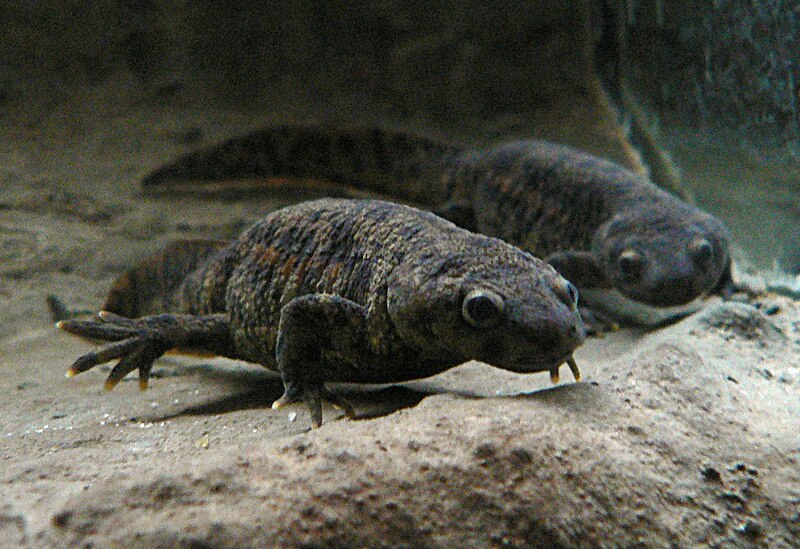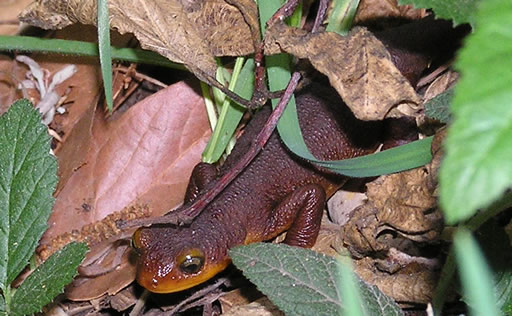As mentioned in Part I of this article, tiger salamander larvae (Ambystoma tigrinum), run through with a hook while alive, are still used as fishing bait in some parts of the USA. Last time we learned about the bait trade’s role in spreading a Chitrid fungus that is decimating amphibian populations worldwide, and in hastening the extinction of endangered tiger salamanders through hybridization.
Endangered but Legally Exploited
 Despite the aforementioned environmental nightmares, the bait trade in tiger salamanders remains largely unregulated, resulting in infected animals being shipped from state to state. This practice hastens the spread of already fast-moving pathogens and of non-native salamanders, as surveys have revealed that most people and bait shops release unused larvae into local waterways.
Despite the aforementioned environmental nightmares, the bait trade in tiger salamanders remains largely unregulated, resulting in infected animals being shipped from state to state. This practice hastens the spread of already fast-moving pathogens and of non-native salamanders, as surveys have revealed that most people and bait shops release unused larvae into local waterways.
The situation is rendered all the more bizarre by the fact that these largest of all terrestrial salamanders are critically endangered in many areas. In fact, several subspecies, including the Eastern tiger salamander (Ambystoma tigrinum tigrinum), are protected by individual states as endangered species!
Other Threats
 Tiger salamanders also face serious threats from habitat loss, pollution and the introduction of game fish to breeding ponds. Their use of two distinct habitats – aquatic and terrestrial – renders them especially vulnerable.
Tiger salamanders also face serious threats from habitat loss, pollution and the introduction of game fish to breeding ponds. Their use of two distinct habitats – aquatic and terrestrial – renders them especially vulnerable.
Protection, when offered, is often ineffective. In New York State, for example, 75 feet of land around breeding ponds is closed to development – but research has shown that few if any adults live within that radius!
Tiger Salamanders in Captivity
Tiger salamanders make interesting and unusually responsive captives. Longevities exceed 30 years, but captive reproduction is still somewhat problematical. They certainly deserve more attention from hobbyists …please write in for further information.
American Bullfrogs
American bullfrogs (Rana/Lithobates catesbeianus) have also recently been implicated in spreading amphibian diseases (New Scientist: May, 2009). Researchers monitoring food markets in NYC and California discovered that 8% of the frogs being offered for sale carried ranavirus and nearly 70% were infected with Chytrid!
Further Reading
You can learn about the natural history of the eastern tiger salamander, and the steps being taken by the NYS DEC to prevent its extinction, at
http://www.dec.ny.gov/animals/7143.html.
The Organization Amphibian Ark has taken a leading role in Chytrid research. Read about how this fungus has caused amphibian extinctions, and predictions for the future of the epidemic, at http://www.amphibianark.org/chytrid.htm.
Image referenced from Wikipedia and originally posted by Tigershrike.
 That Reptile Blog – Reptile, Amphibian and Exotic Pet Care and Information
That Reptile Blog – Reptile, Amphibian and Exotic Pet Care and Information

 Gradually reduce the temperature to 65 F during the night (a basement is ideal) and 68 F during the day (use a small incandescent bulb to raise the temperature) and maintain this schedule for 4 weeks. Thereafter, hold the temperature at 65 F round-the-clock for an additional 2 weeks. The terrarium should be kept in the dark throughout this time, and the frogs should not be fed.
Gradually reduce the temperature to 65 F during the night (a basement is ideal) and 68 F during the day (use a small incandescent bulb to raise the temperature) and maintain this schedule for 4 weeks. Thereafter, hold the temperature at 65 F round-the-clock for an additional 2 weeks. The terrarium should be kept in the dark throughout this time, and the frogs should not be fed. Several salamanders have quite unique ways of distributing their protective secretions – fire salamanders (Salamandra salamandra), for example, can squirt theirs for some distance. Perhaps strangest of all, the Spanish ribbed newt (Pleurodeles waltl) actually drives toxin-tipped ribs through the skin of its back when confronted by a predator!
Several salamanders have quite unique ways of distributing their protective secretions – fire salamanders (Salamandra salamandra), for example, can squirt theirs for some distance. Perhaps strangest of all, the Spanish ribbed newt (Pleurodeles waltl) actually drives toxin-tipped ribs through the skin of its back when confronted by a predator! Over 200 compounds, some of which are medically significant, have been isolated from newt and salamander skins. Western North America’s rough-skinned newt (Taricha granulosa) possesses what may very well be the salamander world’s most powerful secretions…a single adult packs enough to kill 25,000 mice. More than one person (usually male, drunk and involved in some sort of “initiation” or dare), has suffered fatal consequences after swallowing a rough-skinned newt.
Over 200 compounds, some of which are medically significant, have been isolated from newt and salamander skins. Western North America’s rough-skinned newt (Taricha granulosa) possesses what may very well be the salamander world’s most powerful secretions…a single adult packs enough to kill 25,000 mice. More than one person (usually male, drunk and involved in some sort of “initiation” or dare), has suffered fatal consequences after swallowing a rough-skinned newt. Although the California newt’s (Taricha torosa) toxins pale in comparison to those of its rough-skinned cousin, they are not to be trifled with. I kept a California newt with an American eel for 17 years. The eel, a voracious predator that would as soon latch onto my hand as anything else, never once molested its seemingly defenseless tank-mate.
Although the California newt’s (Taricha torosa) toxins pale in comparison to those of its rough-skinned cousin, they are not to be trifled with. I kept a California newt with an American eel for 17 years. The eel, a voracious predator that would as soon latch onto my hand as anything else, never once molested its seemingly defenseless tank-mate.